Abstract
The work presents novel composite catalytic materials—Ni and Co deposited on Magneli phase titania—and describes their complex characterization and integration into membrane electrode assemblies to produce hydrogen by electrochemical water splitting in cells with anion exchange membranes (AEMEC). Chemical composition, surface structure, and morphology were characterized by XRD and SEM analysis. The activity in the evolution of the partial electrode reactions of hydrogen (HER) and oxygen (OER) was assessed in an aqueous alkaline electrolyte (25 wt.% KOH) using linear sweep voltammetry. The interactive role of the support was investigated and discussed. Among the tested samples, the sample with 30 wt.% Co (Co30/MPT) demonstrated superior performance in the OER. The reaction started at 1.65 V, and at 1.8 V, the current density reached 75 mA cm−2. The HER is most efficient on the sample containing 40 wt.% Ni (Ni40/MPT), where the current density reaches 95 mA at a potential of −0.5 V. The change in catalytic efficiency compared to that of the unsupported Ni and Co is due to synergism resulting from electronic interactions between the transition metal having a hyper-d-electron character and hypo-d-electron support. The pre-selected catalysts were integrated in membrane electrode assembly (MEA) using commercial and laboratory-prepared anion-conductive membranes and tested in a custom-made AEMEC. The performance was compared to that of MEA with a commercial carbon-supported Pt catalyst. It was found that the MEA with newly prepared catalysts demonstrated better performance in long-term operation (50 mA cm−2 at 1.8 V in a 60 h durability test), which, combined with the higher cost efficiency, gave credence to considering this combination of materials as promising for AEMEC applications.
1. Introduction
Hydrogen has been considered the energy vector of the future for more than two decades. Recently, it became clear that the large-scale production of green hydrogen is the key success factor for the transformation to a zero-emission economy and that the electrolysis of water powered by renewable energy sources is the only mature technology for this purpose. A new trend in the development of this technology is electrolysers working with polymer anion-exchange membranes (AEMs). The AEM provides high OH-conductivity, separates the H2 and O2 gases produced on the cathode and anode of the cell, and enables both compact system design and high operating pressure. The AEM electrolysis cells with a polymer membrane are expected to combine the advantages of the classical alkaline electrolysers working with aqueous electrolyte and the electrolysis cells using a proton exchange membrane electrolysis cell (PEMEC)—namely, by using non-precious metal catalysts to achieve high operating current densities and a dynamic response to the varying power supplied from renewable sources.
In classical alkaline electrolysis, the electrodes are made from stainless steel or foam nickel. In AEM technology, similarly to PEM water electrolysis, the efficiency of the process can be enhanced by the use of nanosized catalysts dispersed on catalyst carriers with highly developed surfaces [1,2,3,4]. This type of catalyst shows higher activity than the non-supported catalysts. The effect is attributed to the redistribution of the electronic density on the active surface, which optimizes the adsorption strength of the intermediates and facilitates the kinetics of the partial electrode reactions. As a result, the catalytic loading of the electrodes can be reduced essentially to less than 0.5 mg cm−2 while at the same time preserving the efficiency of the electrolysis [5,6,7].
The most commonly used catalysts in AEM water electrolysers for the hydrogen evolution reaction (HER) and the oxygen evolution reaction (OER) are transition metals like Ni and Co, as well as their alloys. One of the most favorable metal oxide materials for OER in alkaline media is NiCo2O4. This material is known for its high electrical conductivity and high number of catalytically active sites. It has a spinel structure and is widely studied as a non-platinum catalyst due to its ability to exhibit a catalytic efficiency comparable to that of platinum-based catalysts [8,9,10]. Another interesting alloy for these partial reactions is NiFeCoP, which has been explored in our previous research. These materials were electrodeposited and investigated in alkaline media, including in AEM water electrolysis and zero-gap configuration with hybrid electrical connections [11,12].
The electrical efficiency and long-term durability of AEM electrolysers are highly dependent on the type of catalytic carrier used. The most commonly used catalytic supports are carbon materials, such as carbon blacks, nanotubes, fibers, etc., known for their excellent electric conductivity and high surface area. The drawback of carbon materials is their inclination to corrosion at the high anode potentials where the oxygen evolution takes place, leading to gradual degradation of the electrodes and consequent failure in the MEA performance. Therefore, in the last decade, intensive research has been carried out on the application of non-carbon-supported catalysts. A variety of materials combining high electrical conductivity and resistance to corrosion, such as metal oxides (SnO2, Ta2O5, TiO2, Nb2O5, WOx, etc.), carbides, or nitrides, have been investigated, and some very promising results have been reported [13,14]. The goal is to develop new generation advanced corrosion-resistant catalysts with zero PGM content, capable of ensuring the superior cost efficiency of the AEMEC and to justify this type of electrolysis as an economically attractive technology for the industrial production of green hydrogen.
This goal is also addressed in this study through the synthesis of Co and Ni nanoparticles deposited on Magneli phase titania (MPT), their complex characterization, and the assessment of their applicability in AEMEC with a laboratory-prepared OH-conducting polymer membrane electrolyte. The aim is to develop composite catalysts with improved efficiency and stability by combining supporting materials with excellent electrical conductivity and high corrosion resistance and transition metals with proven catalytic activity and chemical stability in alkaline media.
According to the literature, the structure of the Magneli phase titania Ti4O7 is a combination of rutile and corundum and has a deficiency of oxygen (Figure 1). It consists of four-unit rutile-like chains bounded by corundum-like planes [15].
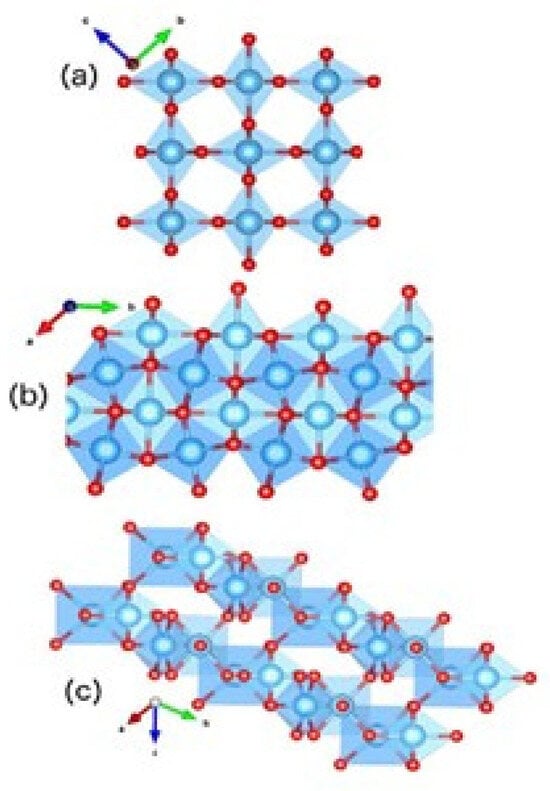
Figure 1.
Schematic structure of (a) rutile, (b) corundum and (c) MPT, which is a combination of both (a) and (b). Ti atoms are the blue spheres enclosed by blue octahedra. The oxygen atoms are the red spheres on the edges of the octahedra.
2. Results
The structure and phase composition of the synthesized materials were examined by X-ray diffraction (XRD). In Figure 2a are presented the results from XRD analysis of the selected catalyst support (MPT). They show that MPT is a mixture of two well recognized crystalline phases—Magneli phase titania Ti4O7 and hollandite K1.28Ti8O16 (1 < x < 1.2). The peaks at 2θ 26.38, 20.78, and 31.76 correspond to the main Ti4O7 Magneli phase (ref. code: 00-072-1722], while the presence of K1.28Ti8O16 is substantiated by the appearance of peaks at 2θ 27.69, 36.11, and 40.35 [ref code: 01-084-2058]. The SEM images in Figure 2b show homogeneously distributed MPT particles with a size in the range of 100–150 nm.
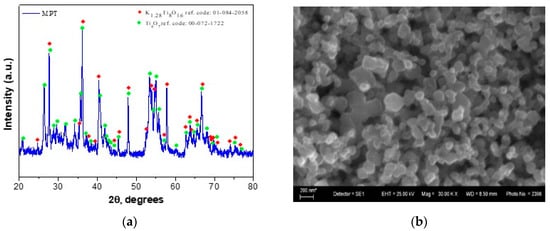
Figure 2.
Structural data of the MPT under study: (a) X-ray diffractograms, (b) SEM images.
The composition, surface structure and morphology of Ni and Co catalysts supported on MPT were also examined by means of scanning electron microscopy (SEM) and X-ray diffraction (XRD). The SEM results showed that the metallic nanoparticles were homogeneously distributed on the support, forming cauliflower aggregates that are illustrated by the microscopic images of selected samples presented in Figure 3. The increase in the active metal of more than 40% wt. leads to agglomeration of the particles and formation of clusters, which in turn, decreases the active surface area, and thus the catalyst efficiency.
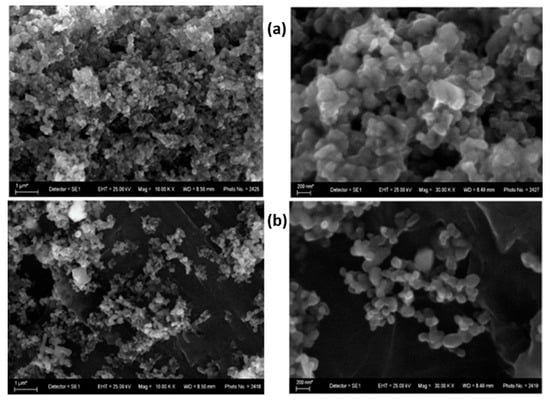
Figure 3.
SEM images of (a) Ni40/MPT and (b) Co30/MPT at different magnifications.
XRD patterns of the synthesized nickel and cobalt catalysts are presented in Figure 4. Figure 4a shows the peak with the greatest intensity at 44.38 2θ, as well as peaks at 51.67 and 76.1 corresponding to the (111), (200), and (220) planes of symmetry of Ni cubic structure and space Fm-3m group (ref. code: 00-065-0380). The results in Figure 4b demonstrate the presence of metallic cobalt in two crystallographic states—hexagonal (ref. code: 00-001-1278), corresponding to the peak with greatest intensity at 47.39 (101), and cubic (111), substantiated with the peak at 44.43 (ref. code: 00-001-1259). Both figures show that the phases of MPT are detected in all samples under study.
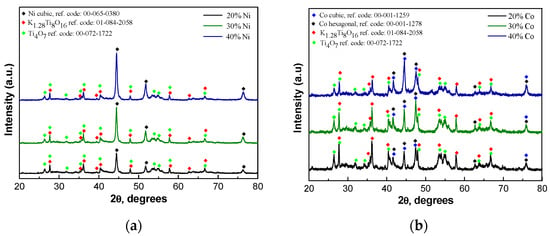
Figure 4.
X-ray diffractograms of the synthesized MPT-supported (a) Ni and (b) Co catalysts.
The size of the catalyst crystallites, t, is shown in Table 1. This is determined by Scherer’s formula t = κλ/Bcosθ, where k is a shape factor (k = 0.9 for spherical crystals), λ (Å) is the wavelength, θ is the diffraction angle of the peak, and B (rad) is the line broadening at the full width at half maximum (FWHM) values of the peaks [16].

Table 1.
Crystallite size of Ni/MPT (a) and Co/MPT (b) catalysts.
The efficiency of the prepared catalysts toward both partial reactions of water electrolysis was evaluated in an aqueous solution of 25 wt.% KOH at room temperature. The influence of the metal content on the catalytic efficiency was investigated using linear sweep voltammetry. It was previously found that Ni/MPT more significantly catalyzes the HER, while Co/MPT is much more efficient in the OER, showing remarkable stability at high anodic potentials [17]. Figure 5 presents the cathodic and anodic polarization curves obtained on electrodes with Ni/MPT and Co/MPT, respectively at different metal: support ratios.
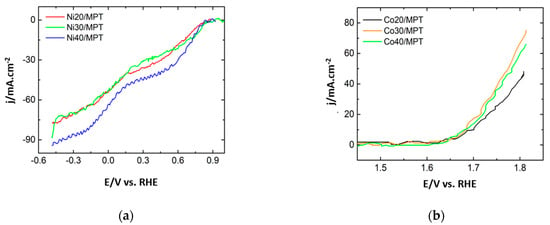
Figure 5.
Polarization curves on Ni/MPT (a) and Co/MPT (b) with varying metal content recorded in 25% KOH at room temperature; potential scan rate: 1 mV s−1.
The obtained results show that the cathodic partial reaction is most intensive on the catalyst with 40 wt.% metal (Ni40/MPT), while the rate of the oxygen evolution on the anode is very similar for Co30/MPT and Co40/MPT and proceeds with higher overvoltage on Co20/MPT. The registered different trend of the catalytic efficiency with the changing metal: support ratio for both metals could be explained with the more homogeneously dispersed Ni compared to Co particles. The cobalt particles at metal content above 30% wt. form bigger clusters, thus decreasing the active surface area available for the electrochemical reaction [18].
The role of the catalytic support is illustrated in Figure 6, where the intensity of the partial electrode reaction on the best performing samples and on non-supported metal nanoparticles is compared. It is seen that HER on the cathode with unsupported Ni nanoparticles proceeds with lower rate compared to Ni dispersed on MPT. The opposite effect is observed for the anode catalysts where the pure Co nanoparticles demonstrate distinct superior OER performance.
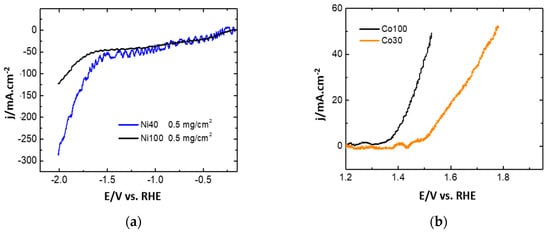
Figure 6.
Polarization curves demonstrating the interactive role of Magneli phase titania as interactive catalytic support; (a) HER on Ni40/MPT and on non-supported Ni, (b) OER on Co30/MPT and on non-supported Co; potential scan rate: 1 mV s−1.
It is well known that the general efficiency of electrocatalysts is determined by two major groups of factors: electronic factors affecting the surface–intermediate bonds strength and geometric factors related to the real active surface area of the catalyst [19,20]. The catalysts under study have similar surface area—they were deposited on the same substrate and XRD data showed similarity in their crystallites size. Therefore, the results obtained cannot be explained with the influence of geometry factors. On the other hand, since the partial electrode reactions are heterogeneous catalytic reactions, their rate depends on the strength of intermediate species–electrode surface chemisorptive bonds, which in turn, is influenced by the electronic density of states in the catalyst atoms. According to the Brewer theory [21], the increase in the electronic density of states increases the availability of metal valence electrons for the formation of chemisorptive bonds, and the result is the weakening of the metal-electron donor bonds such as M-H and strengthening of metal-electron acceptor bonds such as M-O. The decrease in the electronic density of states has an opposite effect. The optimal electrocatalytic activity is achieved at a neither too strong nor too weak level of adsorption bonding, but at a moderate level.
In the case under study, both Ni and Co are hyper-d-metals with electronic configurations [Ar]3d84s2 and [Ar]3d74s2, respectively, and their interatomic interactions with the hypo-d-electron Ti from the support with [Ar]3d34s2 structure should lead to decrease in the electronic density of states. As a result, the strength of the Ni-H bond should decrease, having a positive effect on the efficiency of HER. In contrast, Co-OH and Co-O bonds strength should increase, thus increasing OER overpotential. Based on these considerations and the results from the polarization tests (Figure 5 and Figure 6), it could be suggested with great probability that the registered increase in the efficiency of the composite Ni/MPT catalysts and decrease in Co/MPT performance compared to the pure metals are due to electronic interactions between the hyper-d-electron metals and the hypo-d-electron support. To reveal the exact mechanism of the registered synergetic effects, further focused research is needed that would be outside the scope of this study.
Based on the performed preliminary electrochemical screening of the synthesized catalysts in aqueous alkaline electrolytes, Ni40/MPT and Co30/MPT samples were chosen for further testing in the electrolysis cell with an anion exchange membrane. The fact that AEMECs can run efficiently with non-noble catalysts is one of their most important benefits. Another major advantage is the much lower cost of OH-conductive membranes compared to the proton exchange membranes. On the other hand, the poor thermal and chemical stability of the available commercial anion-exchange membranes as well as their relatively low ionic conductivity are still unsolved issues. The commercially available OH-conductive membranes are mainly based on aromatic and aliphatic resins in ionomeric quaternized ammonia. At elevated temperatures (above 50 °C) and in alkaline environments, these resins are very prone to chemical degradation, leading to a rapid deterioration in performance for all MEA [22,23]. This problem can be solved by using anion-conductive membranes based on the chemically stable polybenzimidazoles (PBIs). The preparation and properties of membranes based on para-polybenzimidazole (p-PBI) doped with 50% aqueous KOH have previously been reported [24,25,26,27].
For the purpose of current research, five MEAs with different types of AEM and different catalysts integrated into the cathode and anode were prepared and investigated. Their composition is given in Table 2.

Table 2.
Composition of the membrane electrode assemblies under study.
In Figure 7c, the cyclic voltamograms of MEA1 and MEA2 are compared with Fumapem and PBI-based membranes, respectively which contain commercial carbon-supported platinum catalyst in both electrodes.
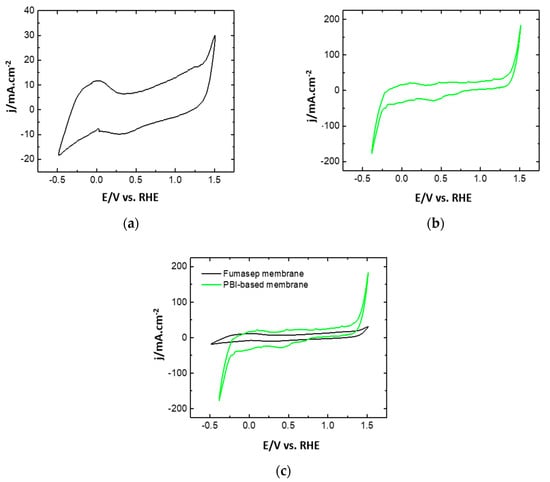
Figure 7.
Influence of membrane type on electrochemical behavior of MEAs with commercial electrodes (0.5 mgPt cm−2) and different electrolyte membranes: (a) Fumapem—MEA1; (b) PBI-based—MEA2; (c) both; potential scan rate: 100 mV s−1.
The surface reactions inherent to Pt can be distinguished on both curves in the relevant hydrogen and oxygen CV branches: adsorption and desorption of hydrogen, coverage of the electrode by oxygen-containing intermediates followed by oxygen evolution and reduction at the reverse potential scan. However, the potential values at which these reactions occur and the measured currents fundamentally differ. The potential window of electrochemical water splitting on MEA1 is above 2.0 V (Figure 7a). The partial reaction of oxygen evolution starts at 1.45 V, while the start-off potential of hydrogen evolution on the cathode is rather high, about −0.55 V. Since the catalytic properties of Pt with respect to these reactions are well known, it can be assumed that the overly wide potential window and high HER overvoltage are due to the low ionic conductivity of the polymer electrolyte. The MEA2 containing the laboratory-prepared PBI membrane shows much better performance (Figure 7b) than MEA1. The characteristic current peaks are clearly illustrated, and the measured currents are considerably higher. The cathode reaction of hydrogen evolution begins at a potential of −0.25 V and its intensity increases rapidly reaching almost 200 mA cm−2 at −0.4 V. The oxygen evolution reaction starts at a potential of 1.4 V, and at 1.5 V, the current density reaches value of 180 mA cm−2. The potential window in which electrochemical water splitting occurs is 1.7 V, i.e., about 300 mV narrower than that of MEA1. For a better visualization of the observed differences, the CVs of both MEAs are compared in Figure 7c.
Similar conclusions can be made when comparing the polarization characteristics of MEA1 and MEA2 presented in Figure 8a,b. Clearly, ohmic losses are significantly lower for the laboratory-prepared membrane than for the commercial Fumasep FA. The oxygen evolution reaction on MEA2 starts at a potential of 1.4 V, which is approximately 200 mV lower overvoltage compared to the same electrode integrated in MEA1 with a commercial membrane. The obtained results clearly show that the laboratory-prepared anion-conducting PBI membrane is much more appropriate as an electrolyte in AEMWE. Therefore, this membrane is further used to assemble MEAs with the synthesized composite MPT-supported catalysts.
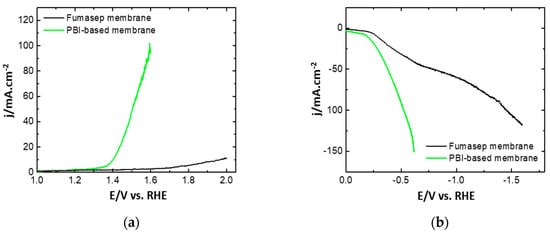
Figure 8.
Influence of the type of membrane on the intensity of: (a) OER and (b) HER.
The performance of the pre-selected catalysts in AEMWE cell was investigated by LSV and chronoamperometry. Figure 9a,b show the cathodic and anodic polarization curves of MEA3 (0.5 mg cm−2 Ni40/MPT at the cathode) and MEA4 (0.5 mg cm−2 Co30/MPT at the anode), respectively. In both figures, the results obtained for MEA2 (0.4 mg cm−2 Pt/C on both electrodes) are also presented for comparison. The curves were recorded under identical conditions with a potential scan rate of 1 mV s−1.
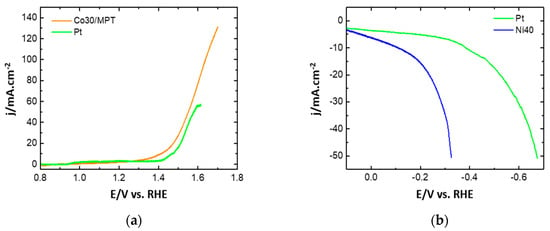
Figure 9.
Polarization curves of MEAs with synthesized MPT-supported catalysts (0.5 mgMe cm−2) and with Pt/C catalyst (0.4 mgPt cm−2) in AEMEC; (a) HER; (b) OER; potential scan rate 1 mV s−1.
The hydrogen evolution reaction on the nickel-based catalyst reaches a current density of 50 mA cm−2 at a potential of −0.3 V, while for Pt, this value is −0.7 V. The obtained results confirm the superior performance of the synthesized composite Ni/MPT compared to Pt/C. Taking into consideration that the rate-determining partial electrode reaction in alkaline water electrolysis is the hydrogen evolution of the cathode, Ni/MPT can be considered as a very promising HER catalyst for water splitting in AEMEC.
The oxygen evolution reaction on Pt/C catalyst starts at a potential of 1.4 V, while on the Co30/MPT—about 50 mV earlier. The current densities observed at a potential of 1.6 V are 55 mA cm−2 and 80 mA cm−2, respectively. At higher potentials, the current density of MEA2 reaches a limiting value, indicating a change in the OER mechanism due to transport limitations or other factors impeding the reaction. In contrast, the polarization curve on the Co/MPT composite catalyst preserves the linear trend, reaching 140 mA cm−2 at potential of 1.7 V. The reason for the observed discrepancy in the performance of both MEA can be explained by their different compositions. The commercial Pt catalysts in MEA2 are supported on carbon black XC72, which at high potentials of the OER, is not electrochemically stable and is prone to oxidation. This leads to the loss of active catalyst surfaces and a decrease in efficiency. Other factors such as transport limitations might be also involved. In contrast, MPT support is very stable under these experimental conditions, which explains why no signs of degradation or loss of OER intensity are observed on the MEA4 polarization curve.
In the final part of this study, an MEA5, with newly developed catalysts integrated in both electrodes (Ni40/MPT on the cathode and Co30/MPT on the anode), was fabricated and its performance at a cell voltage of 2.0 V was followed in a long-term chronoamperometric test. The obtained results are presented in Figure 10. For comparison, the curve recorded on MEA2 under identical conditions is also shown. It is seen that both MEAs demonstrate stable electrochemical behavior for the whole test duration. After some initial oscillations, the current density stabilized and almost did not change until the end of the 240 h experiment. The measured current density on the membrane electrode assembly with the commercial Pt electrodes (MEA2) was comparatively high at the beginning of the test (130–140 mA cm−2). However, the intensity of the electrolysis rapidly decreased with time, reaching a constant current density of 22–25 mA cm−2.
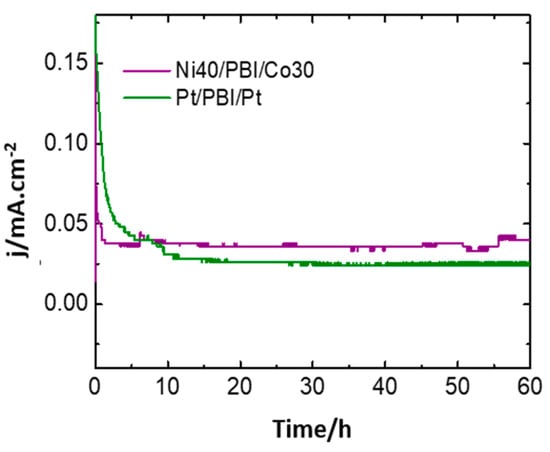
Figure 10.
Chronoamperometric curves of MEA2 and MEA5 in AEMEC; cell voltage: 2.0 V.
The drop in the rate of the process on MEA5 was not as sharp, since it started at a current density of about 50 mA cm−2 lower and reached stability at values in the range of 38–40 mA cm−2, which is about 1.5 times higher than on MEA2. These results once again confirm the stable performance of the novel composite MPT-supported Ni and Co catalysts and justify current research that is focusing on membrane thermal stability, the increase in operating temperature, scaling up of the MEA, and design of a short electrolysis stack.
3. Materials and Methods
The Magneli phase titania (MPT) chosen as catalytic support has excellent electrical conductivity approaching that of a metal combined with high corrosion resistance both in acid and in alkaline media [28,29,30]. In addition, its chemical composition and hypo-d-electron character enable interaction with hyper-d-electron elements form the transition series (Ni, Co, Fe, Mn, etc.), which facilitates the formation of intermediate species on the electrode surface and speeds up the kinetics of the electrode reactions. This synergetic effect is known as strong metal–support interaction (SMSI effect) and is well documented in the literature [31,32,33,34].
In this study, composite catalysts were deposited using a sol–gel process as nanoparticles using acetylacetonate precursors (M((C5H7O2)n)m, (M = Ni, Co) (Alpha Acer) on Magneli Phases Titanium Oxide with the general formula TinO2n−1, (commercially available from Ti-dynamics Co., Ltd., Changsha, China, designated MPT). According to the manufacturer’s technical specification, MPT has an area of 7–8 m2 g−1, very good electrical conductivity and corrosion resistance in both acidic and alkaline environments. The content of the metal part (Co or Ni) varied in the range of 0–40 wt.%. The test samples were denoted MX/MPT where M is Co or Ni and X is the metal content in wt.%. In the first step of the synthesis, the carrier, precursor, and a defined amount of isopropanol were mixed using a magnetic stirrer and then treated in an ultrasonic bath by heating at 60 °C to obtain a fine gel. In the second step, the mixture was heated to 240 °C at a rate of 2 °C min−1 in a reducing atmosphere, and then the temperature was maintained for 2 h, followed by gradual cooling to room temperature. The obtained powder was homogenized in a mortar and stored in a dry oxygen-free atmosphere. Unsupported nanoparticles were also synthesized and investigated to evaluate and better understand the expected metal–support interactions. The structural and phase composition of the prepared materials were examined using X-ray diffraction (XRD). Diffraction data were collected using X-ray diffractometer Philips ADP15 with Cu-Kα radiation λ = 1.54178 Å) at a constant rate of 0.02° s−1 over an angle range from 4° to 80° 2θ. The metal content in the composite catalysts was determined using energy dispersing X-ray analysis while the morphology and surface structure were investigated by scanning electron microscopy. The SEM analysis were carried out using JEOL JSM 6390 electron microscope (JEOL, Tokyo, Japan) (images in secondary and back-scattered electrons), equipped with INCA Oxford elemental detector (
Oxford Instruments, London, UK).
The electrochemical performance of the MPT-supported catalysts was investigated firstly in aqueous alkaline solutions (25 wt.% KOH). To prepare the test electrodes, a catalytic ink was obtained by mixing the powder catalyst with isopropanol, which was then spread on the surface of a commercial gas-diffusion layer (Freudenberg FCCTKG H2315). The screening of the synthesized catalysts was performed in a standard electrochemical cell against a Pt wire as a counter electrode and Ag/AgCl reference electrode by means of linear sweep voltammetry (LSV). The best performing samples were integrated in membrane electrode assemblies using two types of anion exchange membranes—Fumasep FAA-3 with a thickness of 50 μm (commercial product of Fumapem) and a custom-made membrane, based on polybenzimidazole (PBI) doped with KOH under controlled laboratory conditions.
The characteristics of the MEA strongly depend on variety of factors, including the properties of the catalysts, the electrical conductivity and corrosion resistance of the catalytic support, OH conductivity, and the mechanical properties of the polymer electrolyte. In addition, the architecture of the MEA influences gas permeability and hydrophilicity, thus having a serious impact on the transport of reagents to and from the reaction zone where energy conversion takes place, which is another key factor for the efficiency of electrolysis [35,36]. The method and conditions for MEA preparation are also important.
The membrane electrode assemblies investigated in this study had a working area of 0.5 cm−2. Both electrodes were prepared following the already described procedure for the electrodes tested in the aqueous electrolyte. The polymer electrolyte membrane was activated to provide a high OH conductivity, as the exact procedure depended on the type of the membrane used. The commercial Fumasep membrane was activated according to the technical specifications of the manufacturer. It includes immersion for 24 h in 1 M KOH and subsequent rinsing with distilled water. The laboratory PBI-based membrane was provided in an activated form and had a proven high conductivity, which, depending on the temperature and the content of doped KOH (%), was in the range from 298 S cm−1 to 1140 S cm−1 [37,38,39]. The MEA assembling requires binding material to attach the electrodes on both sides of the membrane. For this purpose, an OH-conducting fine gel was prepared by chemical dissolution of a piece of the membrane, which was spread over the catalytic layer of the gas diffusion electrodes and then dried at room temperature for 30 min. The final step was the mechanical clamping of MEA between the current collectors of the test cell, applying an experimentally determined optimal pressure of 8 N m−1.
For the purpose of the research undertaken, five MEAs with different types of membrane and different catalysts integrated into the cathode and anode were assembled. Their performance under electrochemical water splitting conditions was investigated in a custom-made test cell shown in Figure 11. The cell has four hermetically sealed chambers—two for both working electrodes and two for the respective reference electrodes.
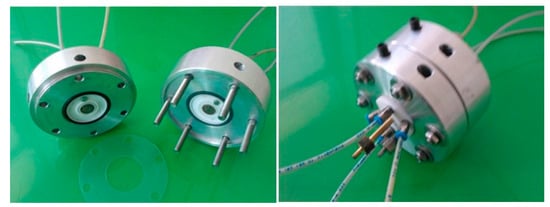
Figure 11.
Pictures of the custom-made test cell.
The cell design allows simultaneous measurement of the anode and cathode polarization as well as monitoring the cell voltage. The current collectors of the cell are made from stainless steel and have flow-field channels to deliver the reagent water and to take off the reaction products (H2 and O2). All experiments reported in this study were carried out at room temperature using Gamry Instruments 1010E (Gamry Instruments, Warminster, PA, USA).
4. Conclusions
The newly synthesized composite non-noble metal catalysts supported in Magneli phase titania demonstrate good efficiency toward electrochemical water splitting in alkaline aqueous media combined with a high chemical stability. The combination of hyper-d-electron transition metals and hypo-d-electron MPT causes the SMSI effect, thus influencing the catalytic performance. The MEAs with the integrated Ni40/MPT cathode, and Co30/MPT anode show better performance than MEAs with Pt/C electrodes under identical experimental conditions. The previously proven high OH conductivity of the doped p-PBI membrane is confirmed when it is integrated in MEA and tested during long-term AEMEC operation. Further research is required to optimize catalyst loading as well as investigate the performance of the studied advanced materials at elevated temperatures and accelerated durability tests.
Author Contributions
Conceptualization, E.S. and G.B.; methodology, E.S., K.M.-D. and B.M.; validation, G.B. and B.M.; formal analysis, G.B.; investigation, G.B.; data curation, B.M.; writing—K.M.-D.; writing—review and editing, E.S. All authors have read and agreed to the published version of the manuscript.
Funding
This research was funded by Bulgarian Science Fund, project KП-06-OПP04/3. The experiments were performed using equipment of project № BG05M2OP001-1.002-0014 “Center of competence HITMOBIL—Technologies and systems for generation, storage and consumption of clean energy”, funded by Operational Program “Science and Education for Smart Growth” 2014–2020 and co-funded by the EU from the European Regional Development Fund.
Data Availability Statement
The data presented in this article are available on request from the corresponding author because they are part of the ongoing study.
Acknowledgments
The authors express their gratitude to the Laboratory of Conjugated Polymers at the Institute of Polymers, Bulgarian Academy of Sciences, for the provision of the PBI-type polymer electrolyte membrane.
Conflicts of Interest
The authors declare no conflicts of interest. The funders had no role in the design of the study; in the collection, analyses, or interpretation of data; in the writing of the manuscript; or in the decision to publish the results.
References
- Kuroda, Y.; Nishimoto, T.; Mitsushima, S. Self-repairing hybrid nanosheet anode catalysts for alkaline water electrolysis connected with fluctuating renewable energy. Electrochim. Acta 2019, 323, 134812. [Google Scholar] [CrossRef]
- Chade, D.; Berlouis, L.; Infield, D.; Nielsen, T.; Mathiesen, T. Deactivation mechanisms of atmospheric plasma spraying Raney nickel electrodes. J. Electrochem. Soc. 2016, 163, F308. [Google Scholar] [CrossRef]
- Todoroki, N.; Wadayama, T. Electrochemical stability of stainless-steel-made anode for alkaline water electrolysis: Surface catalyst nanostructures and oxygen evolution overpotentials under applying potential cycle loading. Electrochem. Commun. 2021, 122, 106902. [Google Scholar] [CrossRef]
- Zeng, K.; Zhang, D. Recent progress in alkaline water electrolysis for hydrogen production and applications. Prog. Energy Combust. Sci. 2010, 36, 307. [Google Scholar] [CrossRef]
- Eiler, K.; Suriñach, S.; Sort, J.; Pellicer, E. Mesoporous Ni-rich Ni–Pt thin flms: Electrodeposition, characterization and performance toward hydrogen evolution reaction in acidic media. Appl. Catal. B Environ. 2020, 265, 118597. [Google Scholar] [CrossRef]
- Ayers, K.; Renner, J.; Danilovic, N.; Wang, J.; Zhang, Y.; Maric, R.; Yu, H. Pathways to ultra-low platinum group metal catalyst loading in proton exchange membrane electrolyzers. Catal. Today 2016, 262, 121. [Google Scholar] [CrossRef]
- Zhong, W.; Tu, W.; Wang, Z.; Lin, Z.; Xu, A.; Ye, X.; Chen, D.; Xiao, B. Ultralow-temperature assisted synthesis of single platinum atoms anchored on carbon nanotubes for efficiently electrocatalytic acidic hydrogen evolution. J. Energy Chem. 2020, 51, 280. [Google Scholar] [CrossRef]
- Suryanto, B.; Lu, X.; Zhao, C. Layer-by-layer assembly of transparent amorphous Co3O4 nanoparticles/graphene composite electrodes for sustained oxygen evolution reaction. J. Mater. Chem. A 2013, 1, 12726. [Google Scholar] [CrossRef]
- Wang, D.; Chen, X.; Evans, D.; Yang, W. Well-dispersed Co3O4/Co2 MnO4 nanocomposites as a synergistic bifunctional catalyst for oxygen reduction and oxygen evolution reactions. Nanoscale 2013, 5, 5312. [Google Scholar] [CrossRef]
- Sa, Y.J.; Kwon, K.; Cheon, J.Y.; Kleitz, F.; Joo, S.H. Ordered mesoporous Co3O4 spinels as stable, bifunctional, noble metal-free oxygen electrocatalysts. J. Mater. Chem. A 2013, 1, 9992. [Google Scholar] [CrossRef]
- Borisov, G.; Bachvarov, V.; Penchev, H.; Rashkov, R.; Slavcheva, E. Multi-metallic electrodeposited catalysts applicable for oxygen evolution reaction in AEM water electrolysis. Mater. Lett. 2021, 286, 129248. [Google Scholar] [CrossRef]
- Borisov, G.; Bachvarov, V.; Rashkov, R.; Slavcheva, E. Advanced Alkaline Water Electrolysis Stack with Non-Noble Catalysts and Hybrid Electrical Connections of the Single Cells. Catalysts 2024, 14, 179. [Google Scholar] [CrossRef]
- Velikokhatnyi, O.; Kumtal, P. Ab Initio Study of Doped Tin Niobates and Tantalates as Prospective Catalyst Supports for Water Electrolysis. ECS Trans. 2010, 28, 37. [Google Scholar] [CrossRef]
- Santos, J.S.; Araújo, P.S.; Pissolitto, Y.B.; Lopes, P.P.; Simon, A.P.; Sikora, M.S.; Strixino, F.T. The Use of Anodic Oxides in Practical and Sustainable Devices for Energy Conversion and Storage. Materials 2021, 14, 383. [Google Scholar] [CrossRef] [PubMed]
- Borisov, G.; Penchev, H.; Maksimova-Dimitrova, K.; Ublekov, F.; Lefterova, E.; Sinigersky, V.; Slavcheva, E. Alkaline water electrolysis facilitated via non-precious monometallic catalysts combined with highly KOH doped polybenzimidazole membrane. Mater. Lett. 2019, 240, 144. [Google Scholar] [CrossRef]
- Wang, G.; Liu, Y.; He, W.; Ye, J. Conduction and sintering mechanism of high electrical conductivity Magneli phase Ti4O7. Ceram. Int. 2023, 49, 27117. [Google Scholar] [CrossRef]
- Rani, N.; Chahal, S.; Chauhan, A.; Kumar, P.; Shukla, R.; Singh, S. X-ray Analysis of MgO Nanoparticles by Modified Scherer’s Williamson-Hall and Size-Strain Method. Mater. Today Proc. 2019, 12, 543. [Google Scholar] [CrossRef]
- Maksimova, K.; Lefterova, E.; Slavcheva, E. Nanostructured nickel and cobalt supported on Magneli—Phase titania—Preparation, properties and catalytic efficiency toward alkaline water electrolysis. Nanosci. Nanotechnol. 2015, 15, 40. [Google Scholar]
- Zeradjanin, A.; Narangoda, P.; Masa, J.; Schlögl, R. What Controls Activity Trends of Electrocatalytic Hydrogen Evolution Reaction? Activation Energy versus Frequency Factor. ACS Catal. 2022, 12, 11597. [Google Scholar] [CrossRef]
- Divanis, S.; Kutlusoy, T.; Boye, I.M.I.; Man, I.C.; Rossmeisl, J. Oxygen evolution reaction: A perspective on a decade of atomic scale simulations. Chem. Sci. 2020, 11, 2943. [Google Scholar] [CrossRef]
- Koper, M.; Marc, M. Activity volcanoes for the electrocatalysis of homolytic and heterolytic hydrogen evolution. J. Solid State Electrochem. 2016, 20, 895. [Google Scholar] [CrossRef]
- Hume-Rothery, W. The Engel-Brewer theories of metals and alloys. Prog. Mater. Sci. 1968, 13, 229. [Google Scholar] [CrossRef]
- You, W.; Noonan, K.; Coates, G. Alkaline-stable anion exchange membranes: A review of synthetic approaches. Prog. Polym. Sci. 2020, 100, 101177. [Google Scholar] [CrossRef]
- Dekel, D. Review of cell performance in anion exchange membrane fuel cells. J. Power Sources 2018, 375, 158. [Google Scholar] [CrossRef]
- Abdi, Z.; Chiu, T.; Pan, Y.; Chien, Y. Anion exchange membranes based on ionic polybenzimidazoles crosslinked by thiolene reaction. React. Funct. Polym. 2020, 156, 104719. [Google Scholar] [CrossRef]
- Hao, J.; Jiang, Y.; Gao, X.; Lu, X.; Xiao, Y.; Shao, Z.; Yi, B. Functionalization of polybenzimidazole-crosslinked poly(vinylbenzyl chloride) with two cyclic quaternary ammonium cations for anion exchange membranes. J. Membr. Sci. 2018, 548, 1–10. [Google Scholar] [CrossRef]
- Guo, M.; Ban, T.; Wang, Y.; Wang, X.; Wang, Z.; Zhu, X. Polybenzimidazoles incorporating imidazole N-spirocyclic quaternary ammonium cation for anion exchange membranes water electrolysis. J. Membr. Sci. 2023, 684, 121903. [Google Scholar] [CrossRef]
- Touni, A.; Grammenos, O.; Banti, A.; Karfaridis, D.; Prochaska, C.; Lambropoulou, D.; Pavlidou, E.; Sotiropoulos, S. Iridium oxide-nickel-coated titanium anodes for the oxygen evolution reaction. Electrochim. Acta 2021, 390, 138866. [Google Scholar] [CrossRef]
- Fan, Y.; Feng, X.; Zhou, W.; Murakami, S.; Kikuchi, K.; Nomura, N.; Wangc, L.; Jianga, W.; Kawasakib, A. Preparation of monophasic titanium sub-oxides of Magnéli phase with enhanced thermoelectric performance. J. Eur. Ceram. Soc. 2018, 38, 507. [Google Scholar] [CrossRef]
- Liu, H.; Xiao, H.; Qiao, Y.; Luo, M.; Wang, C.; Yang, L.; Zeng, C.; Chao, F. Preparation, characterization, and electrochemical behavior of a novel porous Magneli phase Ti4O7-coated Ti electrode. Ceram. Int. 2023, 49, 20564. [Google Scholar] [CrossRef]
- Kim, M.; Choi, J.; Lee, W.; Ahn, Y.-Y.N.; Lee, H.; Cho, K.; Lee, J. Performance of Magneli phase Ti4O7 and Ti3+ self-doped TiO2 as oxygen vacancy-rich titanium oxide anodes: Comparison in terms of treatment efficiency, anodic degradative pathways, and long-term stability. Appl. Catal. B Environ. 2023, 337, 122993. [Google Scholar] [CrossRef]
- Slavcheva, E.; Nikolova, V.; Petkova, T.; Lefterova, E.; Dragieva, I.; Vitanov, T.; Budevski, E. Electrocatalytic activity of Pt and PtCo deposited on Ebonex by BH reduction. Electrochim. Acta 2005, 50, 5444. [Google Scholar] [CrossRef]
- Figueiredo, W.; Prakash, R.; Vieira, C.; Lima, D.; Carvalho, V.; Soares, E.; Buchner, S.; Raschke, H.; Oscar, W.; Lopez, P.; et al. New insights on the electronic factor of the SMSI effect in Pd/TiO2 nanoparticles. Appl. Surf. Sci. 2022, 574, 151647. [Google Scholar] [CrossRef]
- Bertella, F.; Concepcióna, P.; Martínez, A. TiO2 polymorph dependent SMSI effect in Co-Ru/TiO2 catalysts and its relevance to Fischer-Tropsch synthesis. Catal. Today 2017, 289, 181. [Google Scholar] [CrossRef]
- Rajalakshm, R.; Srividhy, G.; Viswanatha, C.; Ponpandian, N. The intriguing bifunctional effect of strong metal support interaction (SMSI) and hydrogen spillover effect (HSPE) for effective hydrogen evolution reaction. Appl. Catal. B Environ. 2023, 339, 12308. [Google Scholar] [CrossRef]
- Knöppel, J.; Möckl, M.; Escalera-López, D.; Stojanovski, K.; Bierling, M.; Böhm, T.; Thiele, S.; Rzepka, M.; Cherevko, S. On the limitations in assessing stability of oxygen evolution catalysts using aqueous model electrochemical cells. Nat. Commun. 2021, 12, 2231. [Google Scholar]
- Lagadec, M.; Grimaud, A. Water electrolysers with closed and open electrochemical systems. Nat. Mater. 2020, 19, 1140. [Google Scholar] [CrossRef] [PubMed]
- Hassan, N.; Zheng, Y.; Kohl, P.; Mustain, W. KOH vs Deionized Water Operation in Anion Exchange Membrane Electrolyzers. J. Electrochem. Soc. 2022, 169, 044526. [Google Scholar] [CrossRef]
- Penchev, H.; Borisov, G.; Petkucheva, E.; Ublekov, F.; Sinigersky, V.; Radev, I.; Slavcheva, E. Highly KOH doped para-polybenzimidazole anion exchange membrane and its performance in Pt/TinO2n−1 catalyzed water electrolysis cell. Mater. Lett. 2018, 221, 128. [Google Scholar] [CrossRef]
Disclaimer/Publisher’s Note: The statements, opinions and data contained in all publications are solely those of the individual author(s) and contributor(s) and not of MDPI and/or the editor(s). MDPI and/or the editor(s) disclaim responsibility for any injury to people or property resulting from any ideas, methods, instructions or products referred to in the content. |
© 2024 by the authors. Licensee MDPI, Basel, Switzerland. This article is an open access article distributed under the terms and conditions of the Creative Commons Attribution (CC BY) license (https://creativecommons.org/licenses/by/4.0/).